Seeing through arthropod eyes: An AI-assisted, biomimetic approach for high-resolution, multi-task imaging
- PMID: 40397741
- PMCID: PMC12094235
- DOI: 10.1126/sciadv.adt3505
Seeing through arthropod eyes: An AI-assisted, biomimetic approach for high-resolution, multi-task imaging
Abstract
Arthropods have intricate compound eyes and optic neuropils, exhibiting exceptional visual capabilities. Combining the strengths of digital imaging with the features of natural arthropod visual systems offers a promising approach to harness wide-angle vision and depth perception while addressing limitations like low resolving power. Here, we present an artificial intelligence-assisted biomimetic system modeled after arthropod vision. We developed a biomimetic compound eye camera with an effective pixel number of 4.3 megapixels capable of producing full-color panoramic images with a viewing angle of 165° and resolving power of 40 micrometers. Using rich visual information, our system achieves high-fidelity image reconstruction, precise 3D position prediction, high-accuracy classification, and pattern recognition through a multistage neural network. Moreover, our compact biomimetic visual system can simultaneously track the 3D motion of multiple miniature targets independently. The proof-of-concept biomimetic arthropod visual system offers a computational panoramic imaging solution, advancing applications in industry, medicine, and robotics.
Figures
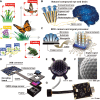
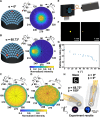
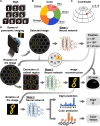

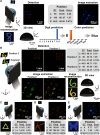
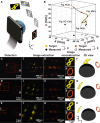
Similar articles
-
A bio-inspired apposition compound eye machine vision sensor system.Bioinspir Biomim. 2009 Dec;4(4):046002. doi: 10.1088/1748-3182/4/4/046002. Epub 2009 Nov 9. Bioinspir Biomim. 2009. PMID: 19901450
-
Stereoscopic artificial compound eyes for spatiotemporal perception in three-dimensional space.Sci Robot. 2024 May 15;9(90):eadl3606. doi: 10.1126/scirobotics.adl3606. Epub 2024 May 15. Sci Robot. 2024. PMID: 38748779
-
Miniature curved artificial compound eyes.Proc Natl Acad Sci U S A. 2013 Jun 4;110(23):9267-72. doi: 10.1073/pnas.1219068110. Epub 2013 May 20. Proc Natl Acad Sci U S A. 2013. PMID: 23690574 Free PMC article.
-
Micro-optical artificial compound eyes.Bioinspir Biomim. 2006 Mar;1(1):R1-16. doi: 10.1088/1748-3182/1/1/R01. Epub 2006 Apr 6. Bioinspir Biomim. 2006. PMID: 17671298 Review.
-
An overview on trilobite eyes and their functioning.Arthropod Struct Dev. 2021 Mar;61:101032. doi: 10.1016/j.asd.2021.101032. Epub 2021 Mar 9. Arthropod Struct Dev. 2021. PMID: 33711677 Review.
References
-
- Aria C., Caron J.-B., A middle Cambrian arthropod with chelicerae and proto-book gills. Nature 573, 586–589 (2019). - PubMed
-
- Strausfeld N. J., Ma X., Edgecombe G. D., Fossils and the evolution of the arthropod brain. Curr. Biol. 26, R989–R1000 (2016). - PubMed
-
- Nilsson D.-E., Kelber A., A functional analysis of compound eye evolution. Arthropod Struct. Dev. 36, 373–385 (2002). - PubMed
MeSH terms
LinkOut - more resources
Full Text Sources

